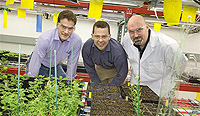Dec 3 2008
Bringing clean tech innovations into the market place faster is the purpose of a new partnership launched this fall between scientists at the Lawrence Berkeley National Laboratory (LBNL) and students of the Berkeley Energy and Resources Collaborative (BERC), an interdisciplinary organization founded by MBA students at the University of California, Berkeley's Haas School of Business.
 Among the Cleantech participants are (L to R) Haas School MBA students Dwight Crabtree and Adam Lorimer, who work with Blake Simmons, manager of the Energy Systems Department at Sandia National Laboratory and vice president of the Deconstruction Division of the Joint BioEnergy Institute
Among the Cleantech participants are (L to R) Haas School MBA students Dwight Crabtree and Adam Lorimer, who work with Blake Simmons, manager of the Energy Systems Department at Sandia National Laboratory and vice president of the Deconstruction Division of the Joint BioEnergy Institute
"Our students have developed a new model of collaboration across disciplines that can break through the bottlenecks that have so often prevented technology transfer from our labs and research centers into the commercial sector," says Jay Stowsky, Haas School senior assistant dean for instruction and former senior economist for science and technology with the White House Council of Economic Advisers.
This is the kind of business process innovation "that can help jump-start sustainable new businesses and industries - something our economy needs dearly right now," Stowsky says.
The partnership called "Cleantech to Market" has already dispatched five cross-disciplinary student teams to evaluate the commercial viability of clean technologies under development at LBNL.
Armed with perspectives from business, law, public policy, engineering, and molecular biology, the students are assessing technologies that include a novel solar-chemical storage device, a breakthrough fabrication method for high-efficiency solid-state photovoltaic devices, and the use of ionic liquids to pre-treat biomass for conversion to biofuel.
In addition to the five teams working to commercialize new technologies, three teams are focused on energy policy and analysis.
Over the course of ten weeks, student teams conduct research and deliver a market analysis. They assess such components as revenue potential, challenges to commercialization, profiles of target customers, and possible venture or industry partners. They will also create a technology marketing description to present to business development professionals, entrepreneurs and venture capitalists.
"We market 40 to 50 technologies a year and we simply don't have the resources to gather in-depth market intelligence for each and every one - yet this kind of research and evaluation can really help to push a new technology into the private sector or into the hands of the right venture capitalist," says Cheryl Fragiadakis, head of the Technology Transfer and Intellectual Property Management Department at LBNL. "To have students apply their talents to readying an entire suite of clean technologies for market is of tremendous value."
The students' work culminates with a presentation to a range of energy experts, from LBNL scientists to venture capitalists and clean tech company representatives, including sponsoring partners, AT&T, Pacific Gas & Electric Co., Siemens Technology-to-Business Center, Rockport Capital and Mohr Davidow Ventures, which are funding the students' stipends.
Cleantech to Market began with the efforts of Berkeley Energy and Resources Collaborative student leaders, who teamed up with LBNL's Technology Transfer Department to create the program. Catherine Wolfram, a Haas School associate professor and the co-executive director of the Center for Energy and Environmental Innovation, also was instrumental in forming the program.
"By forming teams from a talented pool of students, we are not only catalyzing the commercial pathway for technologies at the lab, but also providing opportunities for MBA and other students," says BERC co-chair Naveen Sikka, a 2009 MBA candidate who spearheaded the collaboration.
First-year, full-time MBA students Dwight Crabtree and Adam Lorimer are on a team evaluating an advanced biofuels technology developed at the U.S. Department of Energy's Joint BioEnergy Institute in California. They are investigating the business parameters of going commercial with an enhanced method for pre-treating biomass from wood waste and plants that can be grown on non-agricultural lands.
Lorimer says the new technology promises to solve many problems with existing inefficient and environmentally harmful methods of breaking down the cellulose in these crops into sugars for conversion into liquid fuel.
"These plants and grasses require significantly less water, fuel and fertilizers than food crops," he says. "So this technology promises a genuinely sustainable, low-carbon alternative to petroleum-based transportation fuels."
The team meets regularly with the project's lead researcher, Blake Simmons, manager of the Energy Systems Department at Sandia National Laboratories and vice-president of the Deconstruction Division at the Joint BioEnergy Institute.
"For scientists, new business considerations are typically on the back burner. We are concerned with getting things done in the lab and not how to push our inventions into the real world in the early stages of a project," says Simmons. "Working with students interested in business planning right out of the gate really offers a refreshing perspective.